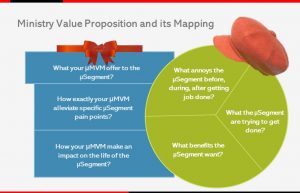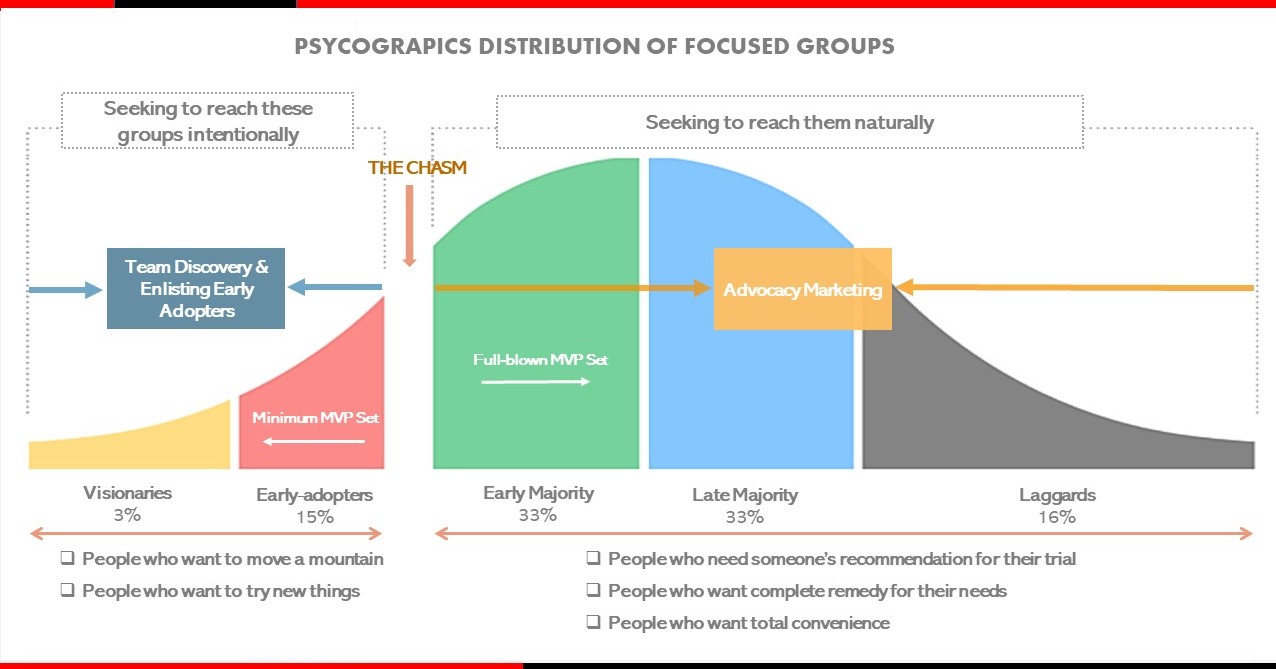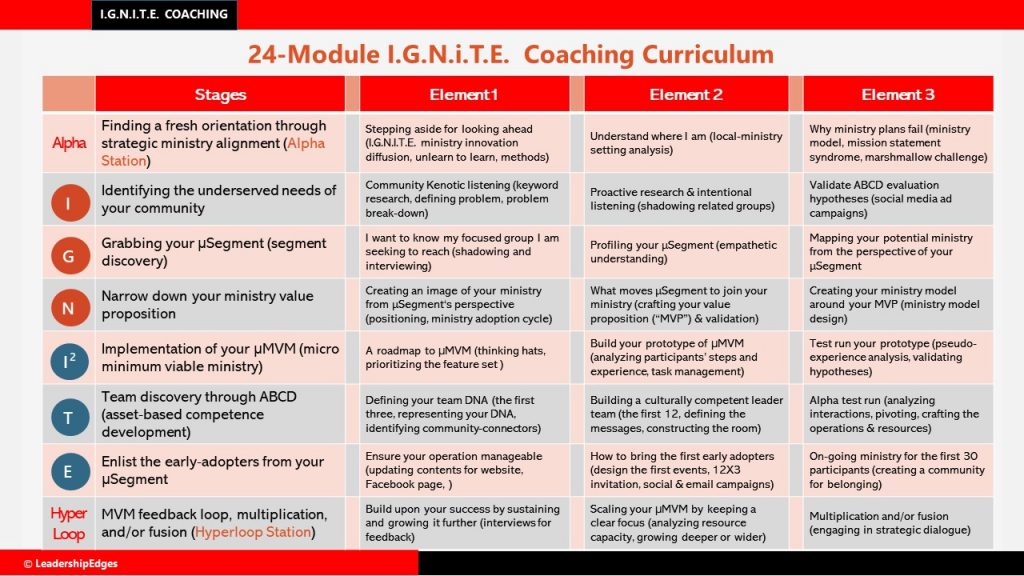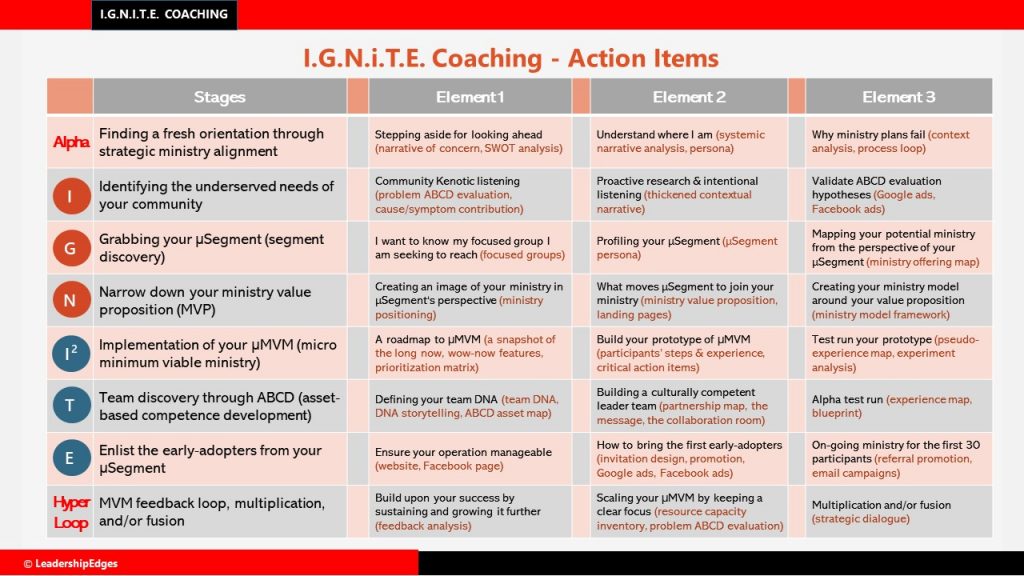Why I.G.N.i.T.E.?
I.G.N.i.T.E. Coaching is NOT for Everyone
I.G.N.i.T.E. Coaching is for

How can a church become resilient enough to mobilize its ministry, break through the barriers it faces, and overcome disruption when confronted with the uncharted territory of the digital age?

How can a church become an inviting and welcoming congregation that instills a feeling of belonging and is wide open to its community? How can it thrive in the digital culture?

How can a congregation equip its leadership with practical competencies so that they operate a ministry that impacts people's lives despite all the adverse statistical reports?
THE AGE OF DIGITAL NOMAD AND SOCIAL DISTANCING
Two new trendy words are representing the COVID-19 pandemic: Digital Nomad and Social Distancing. The associated effects will continue dramatically changing the world we know. It is terrible news for the church with belonging and in-person interactions at the center of its essence. Even before the pandemic, traditional ministries have been disrupted by the digital revolution, and old ministry paradigms stopped working decades ago, with the advent of the digital world in which we live now. Most of the spiritual leaders acknowledge this statement’s veracity because they have personally experienced it; further, statistics indicate that the digital age brought in its wake an inevitable disruption that had an impact on not only churches but all industries. Brick and mortar establishments, which seemed to have a permanent existence, have disappeared for good because of the digital revolution.
How can a church become resilient enough to mobilize its ministry, break through the barriers it faces, and overcome disruption when confronted with the uncharted territory of the digital age?
READY TO PRAY A DANGEROUS PRAYER?
How can a church become an inviting and welcoming congregation that instills a feeling of belonging and is wide open to its community? How can it thrive in the digital culture? How can a congregation equip its leadership with practical competencies so that they operate a ministry that impacts people’s lives despite all the adverse statistical reports?
When seeking to reach new people in your ever-fast changing community, who are thriving in today’s digital culture, we need to produce a strategy continuously adapting to the changes. Duplicating a known good case and introducing it into your local setting does not guarantee your success at all. Instead, the development requires you to analyze, implement, execute, evaluate, and enhance your ministry from multiple perspectives because of your community’s complex diversity and the dynamics brought by your organization.
MULTI-DIMENSIONAL STRATEGY DEVELOPMENT
The new strategy development is multi-dimensional since it involves community needs, ministry practice, community engagement, missional opportunity, community virality, and ministry multiplication and adaptation. If you did not own a unique strategy, something went wrong already.
What I.G.N.i.T.E. Coaching is for?
The purpose of I.G.N.i.T.E. Coaching is to guide motivated spiritual leaders with a simple Ministry Innovation Diffusion process through which you can construct an effective ministry strategy in the frame of your local context.
I.G.N.i.T.E. Coaching differentiates itself by taking a systemic approach blending coaching, consultation, and experiments with a clear focus on your ministry strategy construction and critical leadership development for the emerging culture. It allows engagement with alignment in performance and co-creates individual and team vision leading to collaborative actions.
THE GOALS OF I.G.N.i.T.E. COACHING
A.ctivating
your leader team through Asset-Based Competency Development (ABCD)
B.uilding
up a narrative of concern/opportunity for your community
C.onstructing
your Innovative Ministry Model (IMM) driving results
D.eveloping
your Ministry Value Proposition (MVP) attractive for your focused groups
E.nlisting
the early adopters through Minimum Viable Ministry (MVM) diffusion strategy
F.using
technology platforms into Ministry Operating System (MOS) for maximum impacts
G.rowing
strategically by feeding back your evaluation analysis with a clear focus

DISRUPTIVE MINISTRY INNOVATION DIFFUSION
SIX STAGES OF THE DIFFUSION PROCESS
The Ministry Innovation Diffusion consists of six different stages, captured by the acronym I.G.N.i.T.E.:
- Identify the underserved needs of your community
- Grab your micro-segment (“µSegment”)
- Narrow down your Ministry Value Propositions (“MVP”)
- implement your micro Minimum Viable Ministry (“µMVM”)
- Team Discovery
- Enlist early adopters

THREE INNOVATION SPACES
These stages can be grouped into three innovation spaces:
 The first one consists of three stages in a linear process promoting resilient thinking. Most leaders are trained to evaluate their situations and improve them by adding the required resources and equipping their leadership with needed merits. This approach is working when there exist accumulated assets, including relevant competencies. When it is not the case, many leaders are often confined by scarcity and struggling with an irresistible sense of disappointment, “My church is stuck or stagnant… Is that all there is?”
The first one consists of three stages in a linear process promoting resilient thinking. Most leaders are trained to evaluate their situations and improve them by adding the required resources and equipping their leadership with needed merits. This approach is working when there exist accumulated assets, including relevant competencies. When it is not the case, many leaders are often confined by scarcity and struggling with an irresistible sense of disappointment, “My church is stuck or stagnant… Is that all there is?”
The bottom line of the problem-saturated stories becomes clear that old paradigms are no longer working. We don’t own the cultural competencies necessary to connect with the people we are seeking to reach.
To mobilize your church into your preferred emerging story even in today’s complicated ministry settings, we must impose relevance on our aspiration-based ministry development by taking a new approach that begins with identifying the underserved needs of your community.
Let’s acknowledge that the proposed ministries cannot satisfy everyone. Today, people are customed to high-quality professional services. They are demanding even higher quality, and advanced technologies have made it happen. When we live in a world where one bad review can close down a business, it is terrible news that churches do not own the technological and cultural capacity to provide such a high-quality service. That is precisely why we should intentionally locate a small number of the beneficiary group and to produce your ministry value propositions (“MVP”) just for them. We coach you to correctly narrow down your MVP with higher relevance for the specific group through the Systemic Narrative Thickening process.
 We want to shift from the problem-saturated story that is the current reality to a preferred emerging story. It is itself a ministry idea that is then thickened, validated, planned in the RESILIENT THINKING innovation space, and implemented and executed in THE LOOP.
We want to shift from the problem-saturated story that is the current reality to a preferred emerging story. It is itself a ministry idea that is then thickened, validated, planned in the RESILIENT THINKING innovation space, and implemented and executed in THE LOOP.
The Loop’s secret recipe is to enlist a small number of early adopters only as participants or team members. The scale of it is no more than ten to 30 early adopters to enlist. This Loop must be made within months, like three to four months. The prerequisite to the first round of The Loop is to locate a micro-target segment (“µSegment”) in your community. They should be actively looking for a remedy for their impending underserved needs. More narrow down is your MVP, and more comfortable will it be to enlist them.
The implementation is based on the Minimum Viable Ministry (“MVM”) methodology. The principle is to develop a ministry with the minimum MVP set, which is good enough to alleviate the pain points of the µSegment, without any intention of a full-blown ministry deployment in the first round. The initial Loop should be an experiment or a pilot ministry with a singular purpose of getting real feedback from the first participants. Validating your ministry’s relevance with real focused people and eliminating the gap between hidden assumptions and reality is critical for setting up a viral development of your ministry in your local community. 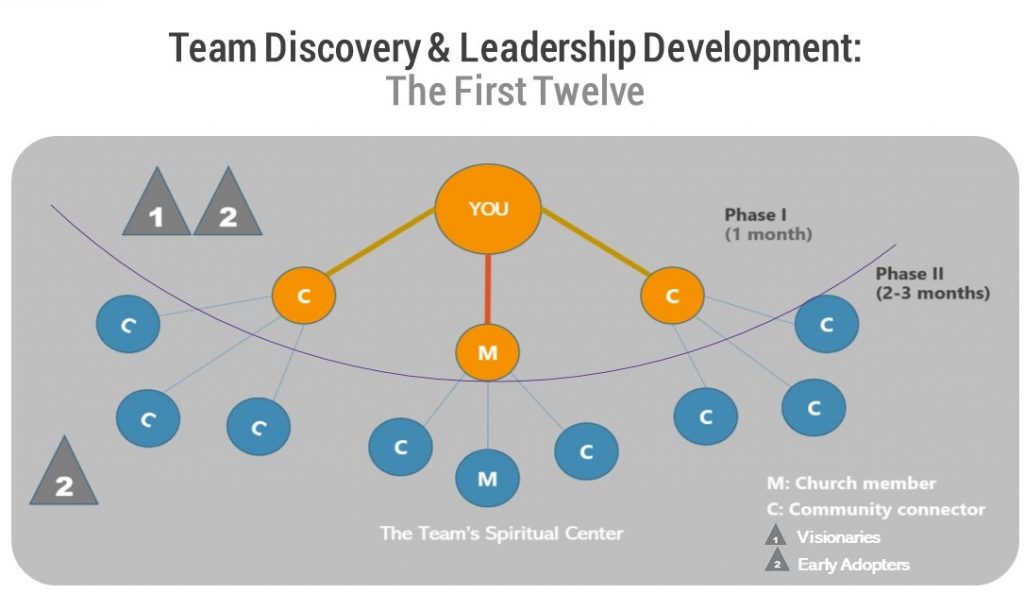
Team Discovery takes two phases. Why two phases? It is to plant a DNA of intentional recruitment practice at the center of your ministry. The community should grow organically. Each member of the community invites no more, no less three people. She or he becomes a caregiver to find the community for their belonging and become self-reliant members of the community as inviting and welcoming their own three people into the community.
Team discovery is not a one-time activity but a recursive reproduction. The fertility rate of three new births may sound too high, but it is not when considering today’s trend that people easily hop to other communities and not easily find a place for their new perpetual home. The net fertility rate near two is a sign that an organism is in a very healthy condition. We coach you on how to maintain an optimum rate. We will analyze your community to find the best rate for growth. We don’t believe faster growth is healthy.
The team discovery and their leadership development should continue in each Loop. It will ensure your ministry’s effective operation even with team members’ short-term commitment of three to four months. The short-term commitment level from your leadership team is mandated in The Loop. It is not because people don’t want to commit themselves to a year-long leadership. Yes, it is easier to recruit leaders with a shorter commitment requirement. One of the most important goals is to establish the just-in-time ministry (“JITM”) model of recruiting needed leaders from existing abundant leadership resources in your community. The effective JITM in your community development is a mark of resilience and Asset-based Competency Development (“ABCD”). The essence of the Innovative Ministry Model is to know how to communicate, get connected, get involved, and collaborate with community connectors. These connectors are bringing the demanded competencies and willing to participate in your ministry for a great cause. These community connectors also play a medium for networking other connectors or connecting people in your community. We coach you on how to onboard them as community co-organizers.
When the first round of The Loop is successfully executed, your ministry team with the First-Twelve members is now activated to run your ministry as they participate in enlisting focused early adopters.
One of the crucial insights in this innovation space is for the team to understand what compelling reasons to join (“CRTJ”). Most people believe they are related to the purpose of your ministry. Most times, it is not. People are motivated by their recognition of a discrepancy between the reality and the desired state. The recognition is a need to change. Whether it is sometimes apparent and other times more latent, it certainly depends on your µSegment faces and how that situation can be improved when they join your project. In other words, the CRTJ is based on specific circumstances motivating your µSegment to join—not ministry attributes. We coach you on how to stimulate the desire for change by developing the CRTJ for your ministry. What messages do you need to construct for meaningful and relevant communications with people of various CRTJs? What channels are there available to reach each CRTJ group? You will be encouraged to study the focused group’s psychographics and use some of their obvious behavioral patterns to explore your options when answering the above critical questions.
We also provide technological platforms, solutions, and methods, including your up-to-date website, landing pages, your private social network, to make your outreaching endeavors possible and practical with those thriving in the culture with technologies at its center.
Feedback collection from those who joined your ministry is a must for successful pivoting the following round of The Loop by analyzing feedback to explore any false assumptions hidden in your ministry development. Rectifying your current MVP and creating the Experience Maps of as many participants before your revisit to Impact and Effort Matrix Analysis would increase your ministry’s relevance to the actual needs of your target segment. The Experience Map allows you to see your ministry through the actual participants’ eyes, including team members. It further helps determine which additional value propositions should be included or omitted in the next round of implementation. This innovation space’s bottom line is to evaluate, pivot, scale your ministry for the next round of The Loop.

Looping back into the Loop with the culturally competent ministry team and MVP, which has been actualized through the feedback analysis, is not the same as the first Loop. It is a Hyper-Loop experience! Your ministry is to be executed in another dimension. The tipping point in ministry growth is no longer its size but the cultural competencies to enlist early-adopters from its communities, who are thriving in the digital culture, and eventually grow with them into a faith community.
No more than three Hyper-looping is recommended before your ministry development set out into a normal ministry life cycle. The reason behind this recommendation is that it is hard to keep up with the values of a Christian community when it grows too fast with new people, possibly unchurched ones. It takes time to develop a character. Resilience and performance are crucial when mobilizing your stagnant church. I.G.N.i.T.E. coaching and the ministry innovation diffusion process is one of the best strategies for such a case. Once successfully mobilized with cultural competencies, a strong recommendation is to adjust the length of The Loop to a more extended period, three to six months, six months to one year during the transition to the normal congregational development life cycle.
ADVOCACY MARKETING
When your community keeps growing and reaches a point when you seek to reach the early majority of your focused group and beyond, Advocacy Marketing should find its place in your Ministry Operating System. It is a form of marketing that emphasizes getting existing participants to talk about their experiences with your ministry. More than 80% of people research online before buying, and having people publicly advocating for your ministry gives these researchers something to find and study.
At this point, you should utilize your website for different types of content. Communicating your MVP alleviating the pain points of the focused early adopters is not enough. Testimonials and stories about those who have joined your ministry become essential. Social Networking should now play a more significant role at this point. However, not many people are willing to play a social media influencer for religious practices, and the use of a private social media network platform is highly recommended. We provide you with a Church Online Platform based on a private social network that has been fully customized for churches. When your community starts to share their stories and invite people in their circles through the platform, ministry innovation finally taps on today’s community’s virality. About 85% of people placed the most trust in the recommendations of friends and family.
Furthermore, about 68% trusted the opinions of actual users they found online. Yes, a significant segment of people is being motivated to join your ministry since it reduces their pains. Before joining your church, a larger group of people are out there, in need of identifying and being associated with others who had similar issues that your ministry resolved.
Advocacy Marketing in this culture is a gem when you excel in your ministry for those first small number of early adopters in the initial Loops. Please don’t use it until it happens. Otherwise, it may become an obstacle for your future ministries. Today, a few bad reviews and a poor online reputation can sink your ministry.
YOUR ROLE AS A COACH AND MODERATOR

While enjoying the leverage created in the first round of The Loop, you would find out it is not easy to lead the whole ministry team in the following rounds. That is a great sign. It is growing pains! Leading a gang of culturally competent leadership is a difficult job. It will be more difficult if they are passionate and motivated. This job demands the role of a professional manager. It is no wonder why those commercial sectors invest a vast amount of financial resources in such a profession. They are the ones who create harmony, direction, and synergy out of your ministry team. When you dare to work with community connectors for the Kingdom’s work, the community organizing pastor should become a professional coach. We have a year-long program for executive ministry coach certification. We have also prepared tools and training sessions to play a moderator role from the second round of The Loop. The moderator’s role is to create a safe collaboration space in which the team can come to make a sound decision for the sake of your community.
Human thinking is unstructured and reinforced so that different types of thoughts can drive individuals and groups to think in unorganized ways. I’ve seen many meetings and discussions led to unexpected results. How do you allow a range of different viewpoints and perspectives to be brought into your development? It is why moderation is an art of work! One of the tools you can use during your team meeting is Six Thinking Hats. The thinking process guides your ministry team to follow specific directions and allows you to moderate the flow of your team discussion productively. You will practice setting an agenda, defining processes and objectives that drive the thinking process forward, collating all the ideas, opinions, and information presented by all the thinking hats, and structuring an action plan for solving the problem.
We also provide you with various templates that can be directly used in your ministry development. They are available in an interactive pdf, including SWOT Analysis, Narrative of Concern and a Preferred Emerging Story, Systemic Narrative Thickening Analysis, Process Loop, Problem ABCD Evaluation, Persona, Context Analysis, Focus Group Shadowing and interviewing, Impact and Effort Matrix Analysis, Ministry Value Proposition and Mapping, Critical Action Plan, Compelling Reasons to Join Analysis, Messages and Channels, Experience Map, Hidden Assumption Analysis, and more.
Furthermore, we will provide training on creating online forms, landing pages, and email campaigns, and how to utilize the Website platform, Church Online Platform, Email Campaign platform, Online Conference platform, Online Learning Management platform, Online Interactive Learning platform, Online Broadcasting System platform, etc.
Do you want FREE consultation?
I.G.N.i.T.E. Coaching Curriculum
24 MODULES
I.G.N.i.T.E. Coaching curriculum consists of 24 modules practically designed from various researches performed by ministry strategists and practitioners.
We will provide you with an online coaching platform containing materials for innovative ministry development frameworks, the practical tools, and methods to excel in ministry innovation.
ACTION ITEMS
You will not only learn about what it will take to move forward step by step in the ministry innovation diffusion but also be guided to complete action item(s) carefully designed for each module. You will be equipped with the required competence to complete each module by executing the action item(s) and advance toward the next module.
A Long-view to Live out Today
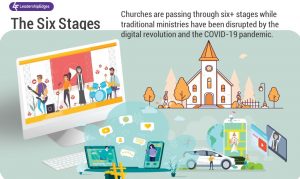 When you pause and take a close look at our past, you can easily find that churches have been passing through certain stages. Some of them have naturally developed and shaped by major drivers like the digital revolution. Some have abruptly appeared due to an unexpected event like the 9.11 tragedy or the COVID-19 pandemic. Major drivers and uncertainties are shaping our future. Future Scenario Planning is to study those future-shaping factors to produce plausible future scenarios. It is not about future prediction. It is all about how to live out today as preparing the dominant future stories. I.G.N.i.T.E. Coaching will promote a long-view in your ministry development with a direction to the most potential future scenarios with a critical question, such as “What will the churches look like in ten years?”
When you pause and take a close look at our past, you can easily find that churches have been passing through certain stages. Some of them have naturally developed and shaped by major drivers like the digital revolution. Some have abruptly appeared due to an unexpected event like the 9.11 tragedy or the COVID-19 pandemic. Major drivers and uncertainties are shaping our future. Future Scenario Planning is to study those future-shaping factors to produce plausible future scenarios. It is not about future prediction. It is all about how to live out today as preparing the dominant future stories. I.G.N.i.T.E. Coaching will promote a long-view in your ministry development with a direction to the most potential future scenarios with a critical question, such as “What will the churches look like in ten years?”
Future Scenario Planning takes an intensive study. The purpose of it to live out today with a purpose and an intention to bridge the gap between today’s narrative of concern or opportunity and the most potential future scenario.
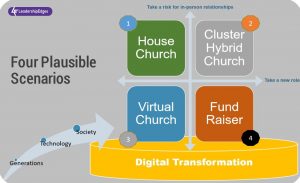 We provide you with our future scenario planning analysis with three core drivers selected after studying eight major drivers shaping our future. Two uncertainties were introduced in this analysis, and it has produced four plausible scenarios. This analysis will help you develop your ministry strategy for an uncharted territory of Church Online.
We provide you with our future scenario planning analysis with three core drivers selected after studying eight major drivers shaping our future. Two uncertainties were introduced in this analysis, and it has produced four plausible scenarios. This analysis will help you develop your ministry strategy for an uncharted territory of Church Online.
We also provide you with our analysis of the past stages since the digital revolution. It will guide you to identify the stage in which your church is passing through. It will help you avoid any pitfalls in the emerging stages.


